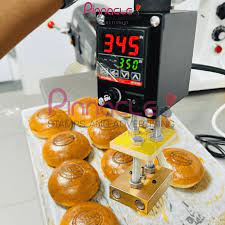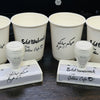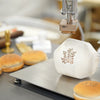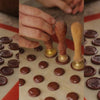The Fusion of Tradition and Technology: Exploring the Electric Iron Stamp

Introduction:
In the dynamic landscape of manufacturing and branding, innovation often arises from the convergence of tradition and technology. One such example is the electric iron stamp, a modern twist on a timeless technique that combines the artistry of traditional stamping with the efficiency of electric heating. In this article, we delve into the fascinating world of electric iron stamp, exploring its evolution, mechanics, applications, and the unique advantages it offers in contemporary manufacturing processes.
A Brief History of Stamping:
The practice of stamping, or marking objects with a distinctive design or inscription, has ancient origins dating back thousands of years. From ancient civilizations such as Mesopotamia and Egypt to medieval Europe and beyond, craftsmen have employed stamps made from various materials, including metal, wood, and clay, to leave their mark on pottery, textiles, and official documents.
Over time, stamping techniques evolved alongside advancements in metallurgy, manufacturing, and branding. The Industrial Revolution brought about the mechanization of stamping processes, with steam-powered presses and later, hydraulic and pneumatic systems, enabling mass production and standardization of stamped goods.
The Mechanics of Electric Iron Stamping:
Electric iron stamping builds upon this legacy of craftsmanship and innovation, marrying the precision of traditional stamping with the convenience and control of electric heating. At its core, the process involves the application of heat and pressure to transfer a design or inscription onto a substrate, such as paper, fabric, or plastic.
The key components of an electric iron stamping system include the stamping die, the heating element, and the substrate:
- Stamping Die: The stamping die, typically made from metal or silicone, contains the desired design or text in raised relief. It serves as the template for transferring the image onto the substrate.
- Heating Element: The heating element, often integrated into the base of the stamp or housed in a separate unit, generates and maintains the necessary heat for stamping. Electric heating elements, such as resistive wires or ceramic heating elements, offer precise temperature control and rapid heating capabilities.
- Substrate: The substrate refers to the material being stamped, which can vary widely depending on the application. Common substrates include paper, cardboard, leather, fabric, plastic, and metal. Each substrate requires specific heat and pressure settings to ensure a clear and durable impression.
The electric iron stamping process begins with heating the stamping die to the desired temperature, typically controlled by a thermostat or temperature regulator. Once heated, the die is brought into contact with the substrate under controlled pressure, causing the design to transfer onto the surface.
Applications of Electric Iron Stamping:
Electric iron stamping finds application across a diverse range of industries, from packaging and labeling to textile manufacturing and branding. Some common uses of electric iron stamping include:
- Product Packaging: Electric iron stamping is widely employed for branding and labeling products in industries such as cosmetics, pharmaceuticals, and consumer goods. From logo placement on packaging materials to product identification tags on clothing and accessories, electric iron stamping offers a durable and aesthetically pleasing solution for customization and branding.
- Textile Embellishment: In the textile industry, electric iron stamping is used to add decorative elements and branding to fabrics, garments, and accessories. From imprinting logos and designs onto t-shirts and apparel to embellishing bags, hats, and shoes with custom motifs, electric iron stamping offers versatility and precision in textile embellishment.
- Stationery and Printing: Electric iron stamping plays a crucial role in the production of stationery, invitations, and promotional materials. Whether creating personalized stationery sets, wedding invitations, or branded marketing materials, electric iron stamping allows for high-quality, customizable prints with crisp detail and vibrant colors.
- Industrial Marking and Identification: In manufacturing and industrial settings, electric iron stamping is used for marking and identifying components, parts, and assemblies. From serial numbers and part numbers to safety warnings and compliance labels, electric iron stamping provides a permanent, legible marking solution that withstands harsh environments and wear over time.
Advantages of Electric Iron Stamping:
Electric iron stamping offers several advantages over traditional stamping methods, including:
- Precision and Consistency: Electric iron stamping allows for precise control of temperature, pressure, and dwell time, resulting in consistent and repeatable impressions across a variety of substrates.
- Efficiency and Productivity: Electric iron stamping systems heat up quickly and require minimal setup time, allowing for rapid production and high throughput in manufacturing environments.
- Versatility and Customization: Electric iron stamping can accommodate a wide range of stamp designs and substrates, making it suitable for diverse applications and customization options.
- Durability and Longevity: Electric iron stamped impressions are durable and resistant to fading, smudging, and abrasion, ensuring a lasting mark that withstands the rigors of handling and use.
Conclusion:
In the ever-evolving landscape of manufacturing and branding, electric iron stamping stands out as a versatile and efficient technique that combines the best of tradition and technology. From its ancient origins in craftsmanship to its modern applications in industrial production, electric iron stamping continues to leave its mark on a wide range of products and industries.
As advancements in materials science, automation, and digital imaging drive further innovation in electric iron stamping technology, the possibilities for customization, efficiency, and quality assurance are boundless. Whether used for branding, labeling, or personalization, electric iron stamping offers a compelling solution for manufacturers seeking to elevate their products and leave a lasting impression on customers and clients alike.





